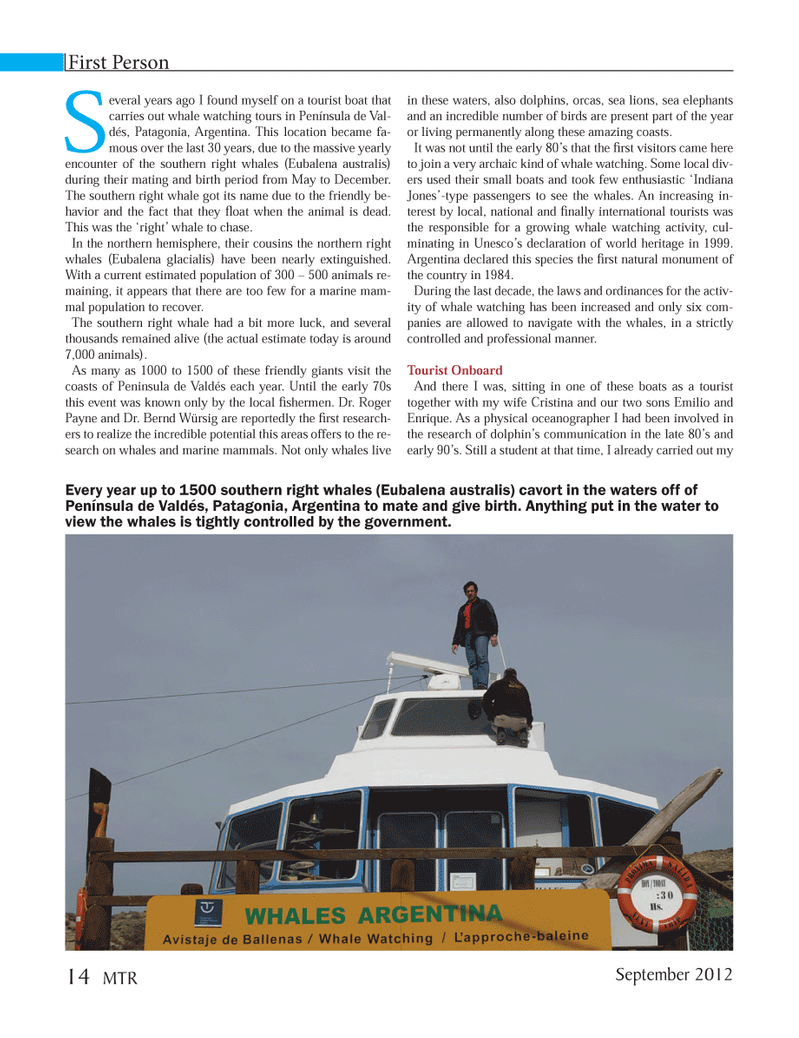
Page 14: of Marine Technology Magazine (September 2012)
Subsea Defense: Protecting Port & Subsea
Read this page in Pdf, Flash or Html5 edition of September 2012 Marine Technology Magazine
Several years ago I found myself on a tourist boat that carries out whale watching tours in Península de Val- dés, Patagonia, Argentina. This location became fa- mous over the last 30 years, due to the massive yearly encounter of the southern right whales (Eubalena australis) during their mating and birth period from May to December. The southern right whale got its name due to the friendly be-havior and the fact that they oat when the animal is dead. This was the ?right? whale to chase. In the northern hemisphere, their cousins the northern right whales (Eubalena glacialis) have been nearly extinguished. With a current estimated population of 300 ? 500 animals re- maining, it appears that there are too few for a marine mam- mal population to recover. The southern right whale had a bit more luck, and several thousands remained alive (the actual estimate today is around 7,000 animals). As many as 1000 to 1500 of these friendly giants visit the coasts of Peninsula de Valdés each year. Until the early 70s this event was known only by the local shermen. Dr. Roger Payne and Dr. Bernd Würsig are reportedly the rst research- ers to realize the incredible potential this areas offers to the re- search on whales and marine mammals. Not only whales live in these waters, also dolphins, orcas, sea lions, sea elephants and an incredible number of birds are present part of the year or living permanently along these amazing coasts. It was not until the early 80?s that the rst visitors came here to join a very archaic kind of whale watching. Some local div- ers used their small boats and took few enthusiastic ?Indiana Jones?-type passengers to see the whales. An increasing in- terest by local, national and nally international tourists was the responsible for a growing whale watching activity, cul- minating in Unesco?s declaration of world heritage in 1999. Argentina declared this species the rst natural monument of the country in 1984.During the last decade, the laws and ordinances for the activ- ity of whale watching has been increased and only six com- panies are allowed to navigate with the whales, in a strictly controlled and professional manner. Tourist Onboard And there I was, sitting in one of these boats as a tourist together with my wife Cristina and our two sons Emilio and Enrique. As a physical oceanographer I had been involved in the research of dolphin?s communication in the late 80?s and early 90?s. Still a student at that time, I already carried out my First Person Every year up to 1500 southern right whales (Eubalena australis) cavort in the waters off of Península de Valdés, Patagonia, Argentina to mate and give birth. Anything put in the water to view the whales is tightly controlled by the government. September 201214 MTRMTR #7 (1-17).indd 14MTR #7 (1-17).indd 149/10/2012 11:57:15 AM9/10/2012 11:57:15 AM

 13
13

 15
15
